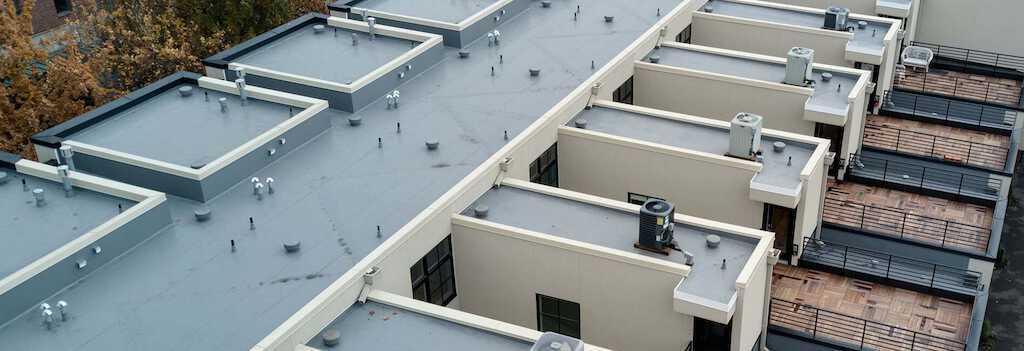Did you know that in 2019, the estimated loss of revenue due to storms on commercial businesses was $9 billion? With the uptick in severe weather impacting commercial buildings, it’s more important than ever to have the right roofing material.
The best roofing material is PVC, which has many benefits including its durability, weather resistance, and energy efficiency. Here’s how you can take advantage of PVC roofing installation to protect your business from extreme weather and other types of damage.
What Is PVC Roofing?
Among its other qualities, PVC is water-tight, fire resistant, and eco-friendly. It’s one of the best options for ensuring that your roof will stay in good shape for as many years as possible. PVC is also the easiest of roofing materials to repair, with a lifespan of up to 30 years.
PVC is also known for its reflective qualities and UV resistance. White and other light colors are commonly used in PVC roofs to reflect sunlight and reduce the amount of air conditioning needed in a building.
There are three main types of PVC roofing membrane; standard, KEE, and fleece-backed. The specific type you choose to utilize on your roof will depend on various factors such as your budget and the location of the building.
A standard PVC membrane is a single-ply, Energy Star-rated material that works best on low-sloped and flat roofs. These are generally constructed with two outside membrane layers and a layer of polyester in the middle.
The way PVC roofing works is through elasticity, which involves expanding and contracting when put under stress. Ketone Ethylene Ester (KEE) is added to PVC to increase its elasticity, durability, and fire resistance compared to standard PVC.
Fleece Backed PVC has several advantages compared to PVC KEE and standard PVC, including its increased impact resistance and faster installation process.
The Process of PVC Roofing Installation
There are three main methods of installing a PVC membrane; fully adhered, mechanical, and ballasted.
The fully adhered method involves gluing the membrane down with adhesive. It’s generally used to install roofing on a roof deck made of concrete, or similar material to avoid extensive bolting to the roof deck.
However, this comes at the cost of being prone to condensation forming, which may cause the adhesive to fail, and leave it vulnerable to wind damage. This method should also not be used in climates where the temperature is below 40° F, as the adhesive will freeze.
Mechanical installation uses screws and metal plates to adhere the roofing to the roof deck. For businesses located in climates where extended periods of wind and storms often occur, this is an especially good option. The roofing adheres in such a way that it’s extremely resilient to wind damage.
Ballasted installation involves using materials to weigh down the roofing. These are usually made of rock, gravel, concrete, or other heavy material.
But this method can add a significant amount of weight to the roof which may strain the building’s infrastructure. This is emphasized for buildings in climates that have harsh winters, as snow can contribute more weight. Maintaining a ballasted roof is also more difficult as leaks are harder to detect.
Cost
The cost of commercial PVC roofing depends on several factors. These include the size of the roof and ease of access to it, the location of your building, relevant building codes, and the type of PVC roofing membrane you choose to install.
Size of & Ease of Access to the Roof
Commercial roof installation is priced by the square foot, so the larger the roof, the more expensive this installation will be. If the old roof is being removed, the cleaning and preparation for removal can cost around $.10-$.75 per square foot. The actual removal cost will cost approximately $1-$2 per sq foot.
If your building is taller or there would need to be special precautions to install a new roof, this will be more expensive. You can expect to incur costs for special machinery required to reach the roof.
Location
Certain locations, such as those prone to heavy rains and other extreme weather patterns, will need to be more selective. While PVC is very durable, you’ll need to take extra steps to ensure that your roof is ready to withstand the weather.
Building Codes
The International Code Council’s International Building Code specifies minimum requirements for commercial properties, including guidelines on roof drainage, coverings, and fire and wind resistance. In Illinois, the specific guidelines to follow are determined on a local level. While taking the steps to install your new roof up to code can lead to extra costs, it’s worth it to have a safe roof.
Type of PVC Membrane
PVC roofing materials can vary in cost, although it’s generally more expensive as an up-front cost that pays off with lower repair costs. Standard PVC has costs ranging from $4 to $12, depending on the brand. For KEE roofing, you may pay anywhere from $1.50 to $8 per square foot.
Protect Your Commercial Building With a New PVC Roof
Investing in PVC roofing installation on your commercial property can keep the roof in good shape for decades to come. Whether you choose a standard PVC membrane or a different PVC material, make sure that you hire a qualified contractor to handle it.
Our team at Williams Roofing in Illinois has been in business for over 35 years. We use high-quality products to provide roofing services for commercial systems. Whether your roof needs a repair or a complete replacement, our PVC roofing services should be your go-to.

